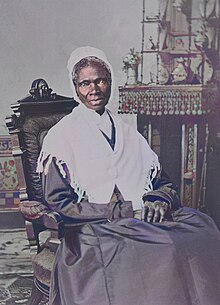
Back سوجورنر تروث Arabic سوجورنر تروث ARZ Sojourner Truth AST Соуджърнър Трут Bulgarian Sojourner Truth BS Sojourner Truth Catalan Sojourner Truth Czech Sojourner Truth Welsh Sojourner Truth Danish Sojourner Truth German
Sojourner Truth | |
|---|---|
 Truth, c. 1870 | |
| Born | Isabella Baumfree c. 1797 Swartekill, New York, U.S. |
| Died | (aged 86) Battle Creek, Michigan, U.S. |
| Occupation(s) | Abolitionist, human rights activist |
| Parent(s) | James Baumfree Elizabeth Baumfree |
Sojourner Truth (/soʊˈdʒɜːrnər, ˈsoʊdʒɜːrnər/;[1] born Isabella Baumfree; c. 1797 – November 26, 1883) was an American abolitionist and activist for African-American civil rights, women's rights, and alcohol temperance.[2] Truth was born into slavery in Swartekill, New York, but escaped with her infant daughter to freedom in 1826. After going to court to recover her son in 1828, she became the first black woman to win such a case against a white man.
She gave herself the name Sojourner Truth in 1843 after she became convinced that God had called her to leave the city and go into the countryside "testifying to the hope that was in her."[3] Her best-known speech was delivered extemporaneously, in 1851, at the Ohio Women's Rights Convention in Akron, Ohio. The speech became widely known during the Civil War by the title "Ain't I a Woman?", a variation of the original speech that was published in 1863 as being spoken in a stereotypical Black dialect, then more commonly spoken in the South.[4] Sojourner Truth, however, grew up speaking Dutch as her first language.[5][6][7]

During the Civil War, Truth helped recruit black troops for the Union Army; after the war, she tried unsuccessfully to secure land grants from the federal government for formerly enslaved people (summarized as the promise of "forty acres and a mule"). She continued to fight on behalf of women and African Americans until her death. As her biographer Nell Irvin Painter wrote, "At a time when most Americans thought of slaves as male and women as white, Truth embodied a fact that still bears repeating: Among the blacks are women; among the women, there are blacks."[8]
A memorial bust of Truth was unveiled in 2009 in Emancipation Hall in the U.S. Capitol Visitor Center. She is the first African American woman to have a statue in the Capitol building.[9] In 2014, Truth was included in Smithsonian magazine's list of the "100 Most Significant Americans of All Time."[10]
- ^ Wells, John C. (2008). Longman Pronunciation Dictionary (3rd ed.). Longman. ISBN 978-1-4058-8118-0.
- ^ "Sojourner Truth Was a 'Double Woman' in More Ways than One". ChristianityToday.com. November 3, 2023. Retrieved April 3, 2024.
- ^ The Norton Anthology of African American Literature, 3rd Edition, Vol 1
- ^ Thomas, Erik R. (2006). "Rural White Southern Accents". In Labov, William; Ash, Sharon; Boberg, Charles (eds.). Atlas of North American English (online) (PDF). New York: Walter de Gruyter. p. 6. Archived from the original (PDF) on December 22, 2014.
- ^ Margaret Washington (2011). Sojourner Truth's America. University of Illinois Press. p. 13,14.
- ^ Mary Grace Albanese (2023). Black Women and Energies of Resistance in Nineteenth-Century Haitian and American Literature. Cambridge University Press. p. 15,100,101,105,106,107,166,167.
- ^ Kimberly Rae Connor (2023). Conversions and Visions in the Writings of African-American Women. Univ. of Tennessee Press. p. 75,284.
- ^ National Women's History Museum (January 24, 2019). "Sojourner Truth".
- ^ "Sojourner Truth Bust Unveiled in Capitol". Roll Call. April 28, 2009. Retrieved February 14, 2020.
- ^ "Meet the 100 Most Significant Americans of All Time". The Smithsonian. November 17, 2014. Retrieved September 14, 2015.
© MMXXIII Rich X Search. We shall prevail. All rights reserved. Rich X Search